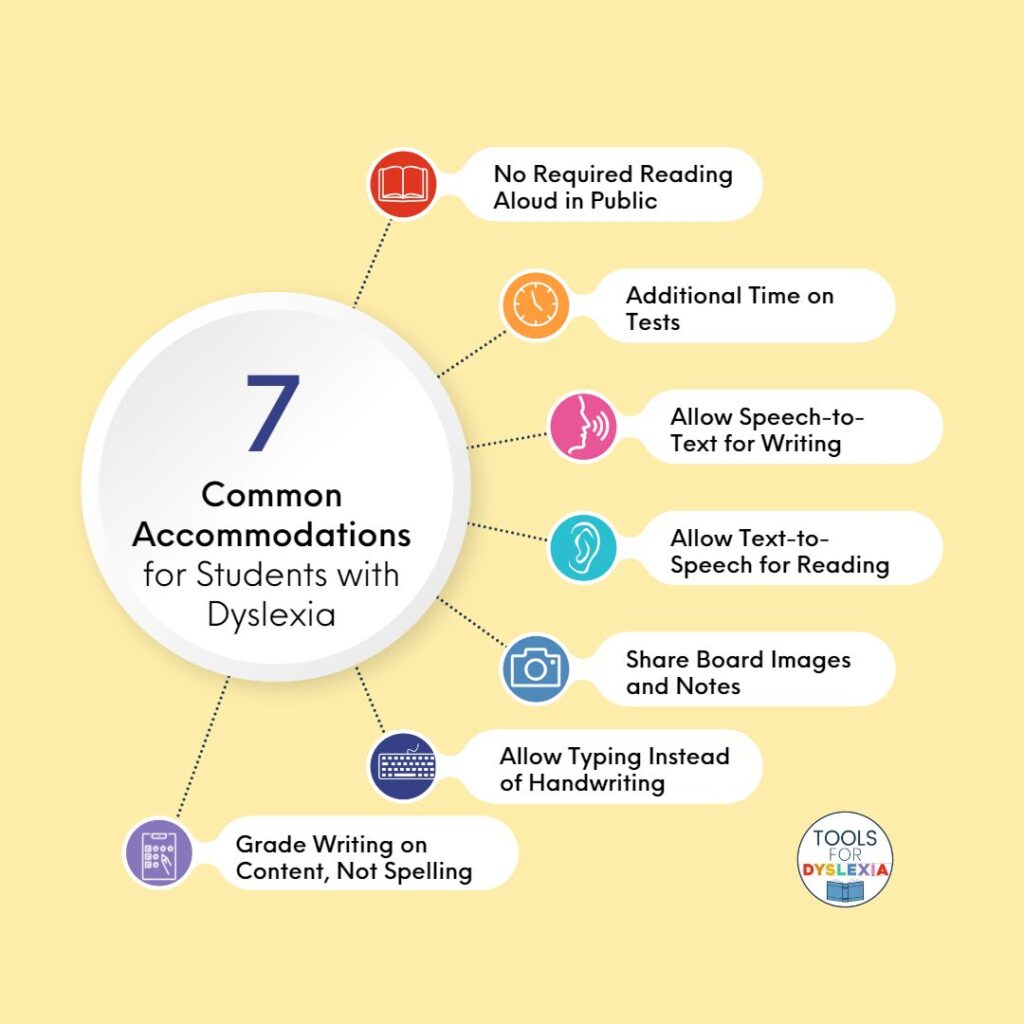Simple Accommodations for Dyslexic Students
(This post contains affiliate links. Read my full disclosure.)
Students with dyslexia benefit from simple accommodations. What are accommodations? How do they help students? Which accommodations will benefit your student?
An accommodation is a change that removes a barrier to learning or getting work done.
Andrew M.I. Lee, JD
Here are seven simple accommodations for students with dyslexia:
- No Required Reading Aloud in Public
- Additional Time on Tests
- Speech-to-Text Assistive Technology for Writing
- Text-to-Speech Assistive Technology for Reading
- Share Classroom Board Images and Share Notes
- Typing Instead of Handwriting
- Grade Writing on Content Rather Than Spelling

Let’s take a look at each of these.
No Required Reading Aloud in Public
Is a classroom public? Yes. If struggling readers are required to read aloud in front of peers, they feel exposed. I know adults who refuse to read aloud in front of other adults or even in front of their own children or grandchildren. It’s embarrassing when you’re stumbling over words and even well-meaning peers or younger relatives are correcting you.
The stress of that public performing gets in the way of the brain’s ability to take in information and make sense of it. Privately reading aloud with a supportive tutor or a parent can be helpful to give the student practice and confidence. But it should be private, without other siblings or students around.
With our daughter, her teachers understood that she would volunteer if she wanted to read aloud. It was her choice.
They’ll likely learn more from listening to the material than having to read for their peers.
Additional Time on Tests
Timed anything stresses many people. But there have to be limits on how long test-takers have to finish. Students who have dyslexia often struggle with reading, comprehension, working memory, processing speed, etc. They need additional time. They also likely need a quiet, distraction free place to take tests.
We might think a classroom is quiet during a test. But some students, like my daughter, are distracted by the noise of chairs shifting on the floor, students energetically erasing mistakes, etc. We want students to do their best and have the best opportunity to show what they know. Give them additional time and real quiet.
Speech-to-Text Assistive Technology for Writing
Writing is a complex process. Fortunately, there are programs that break down the process into bite-size steps. But even with that, students have to think about their message, put the information into complete sentences that make sense, and check the spelling and punctuation. They also likely have a rubric of key items their teacher wants them to include.
It’s no wonder the Hank Zipzer character freaks out about writing. Hank has dyslexia and writing is a stressful challenge for him.
There are lots of options like Microsoft Dictate and subscriptions such as Don Johnston’s Co: Writer. Voice typing takes some practice. But the rewards are likely to be more mature writing and word choice. It allows them to more freely express their thoughts without limiting themselves to words they can spell.
Text-to-Speech Assistive Technology
Another simple accommodation is giving students access to text-to-speech. These tools make learning from textbooks and websites easier for your students. Students turn on the software and information is read to them. Reading speed and voices can be adjusted to fit their needs.
Reading along with the voice, they’ll likely digest more information and more complex materials than they would reading on their own.
While audiobooks aren’t the same as text-to-speech software, they bring students nonfiction and fiction materials that might be beyond their reading ability. Audiobooks are popular and make ear reading accessible anywhere.
Sharing Classroom Board Images and Notes
Writing notes while listening to a speaker can be difficult. You’re trying to follow the story they’re telling, understand the vocabulary they’re introducing, and copy down important information that’s being presented on a board.
Spelling can get in the way of writing and even copying. For students who memorize spelling easily, they don’t have to copy letter by letter the words on the board. But your students with dyslexia do. It’s a stressful, tedious process because the lecture and discussion move faster than they can write.
Ask teachers to share a picture of board notes. Or let students do it. They all have phones now, don’t they?
Teachers can make the notes available to students. Sure, there’s benefit in their writing them, but is that the final goal? No, the goal is for them to learn the material. Give them the notes so they can study them.
Typing Instead of Handwriting
Often an issue with note-taking, worksheets, and on-demand writing is the physical act of holding a pen or pencil and forming letters. For some it’s truly painful after a short while writing. Let them type. Help them learn to type early and encourage them to type efficiently, i.e. correctly rather than hunt-and-peck typing.
One student who began typing surprised me with how accurate his spelling became compared to handwritten spelling. And the spellcheck was turned off so that wasn’t giving him hints. It made a huge difference.
Grade Writing on Content, Not Spelling
We write to communicate and misspellings get in the way of that. That’s true. But students learning to communicate shouldn’t have points taken off for spelling when the assignment is writing. Writing is a complex skill. I’ll say it again.
Check the content. Check the rubric. Ask teachers to make a list of misspelled words and teach them about the spelling patterns and related words. We need to do more teaching of spelling and less “Here’s a list, learn it.”
Remove the barriers to learning and showing what they’ve learned with simple accommodations. They are tools for dyslexia.


